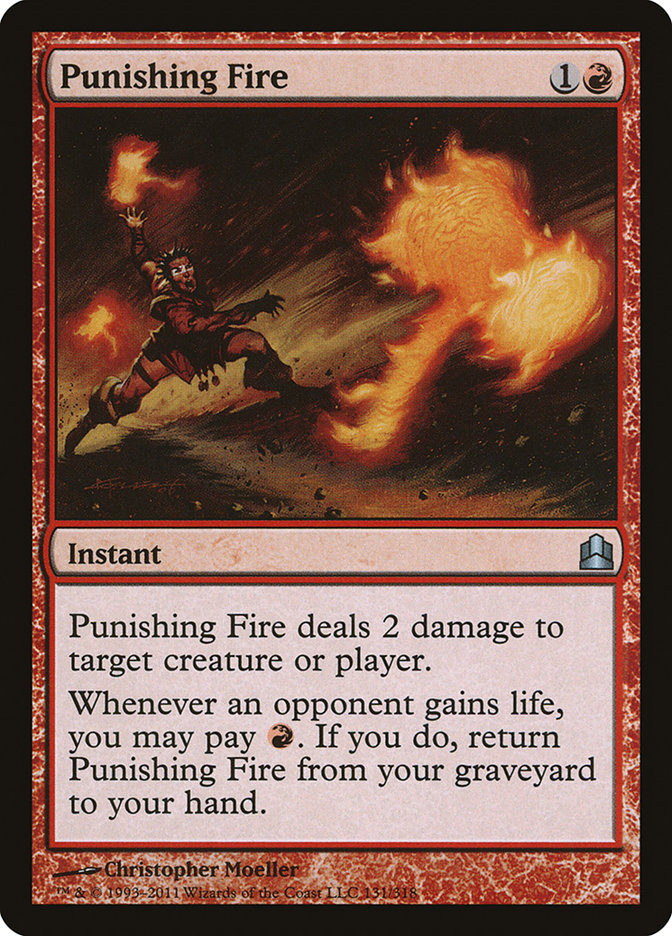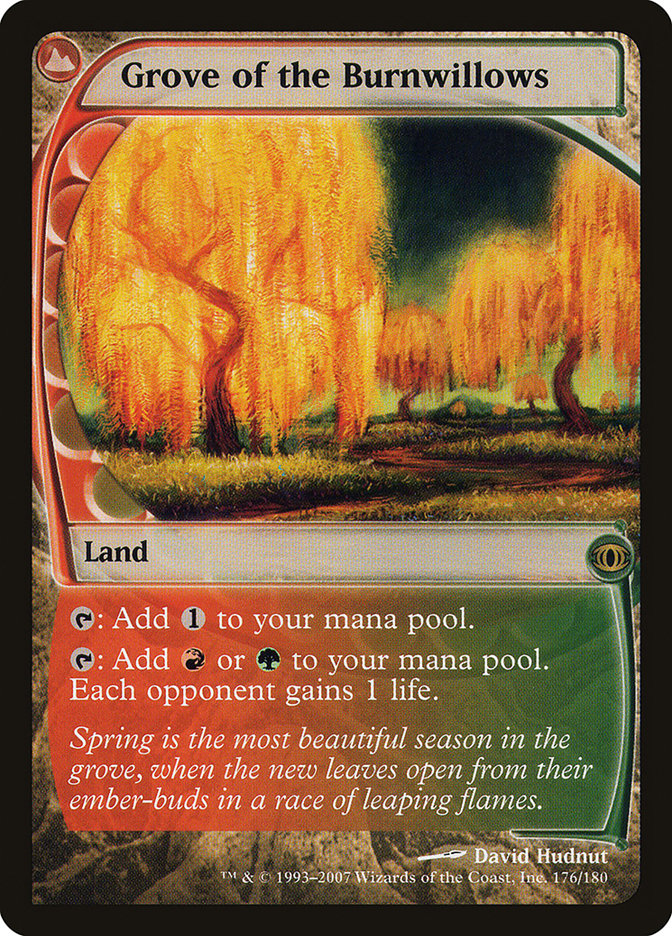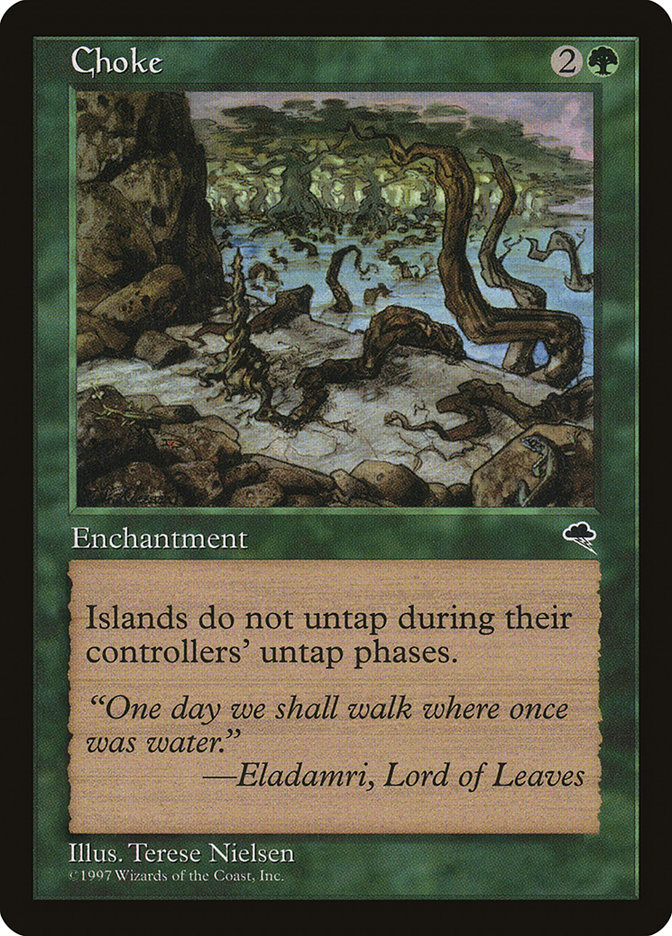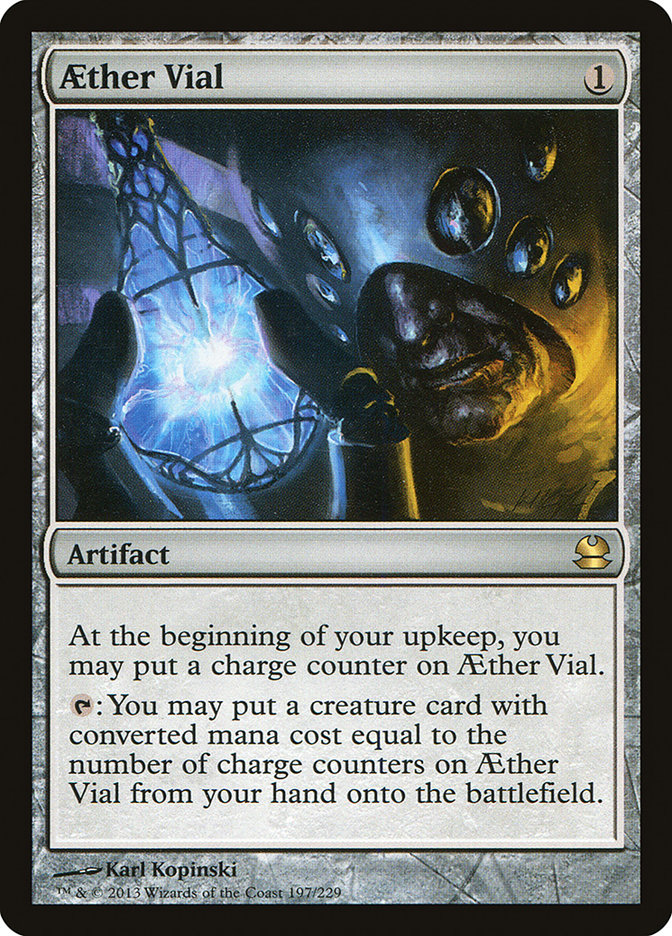Even before I was a tournament player, Legacy fascinated me. More so than Standard, Extended, or anything else, it stimulated the mad scientist in me. With no restrictions on the card pool, there are no restrictions on the possibilities; it would take 10,000 players 10,000 years to try everything! This is why I feel disappointed whenever I see some Brainstorm based archetype dominating the format, putting five decks in every Top 8 with only a couple of cards changed between each list.
That’s really not Legacy! Sometimes that’s what happens in a small snapshot of time—a single month, week, or tournament—but it’s only because of short-term trends and a lack of creativity. I truly believe that in Legacy if you need to beat a certain deck, the answers are out there! Brainstorm and Force of Will are not the only valid shell for a Legacy deck. There’s Burn, Pox, Lands, Elves, and a hundred other strategies that haven’t even been invented yet; it just takes a little bit of vision and daring. The results of last weekend’s StarCityGames.com Legacy Open in Baltimore have inspired me to examine just a few of the alternative strategies of the format that can really allow you to catch your opponents off guard.
Blood Moon
Creatures (19)
- 1 Goblin Welder
- 4 Imperial Recruiter
- 1 Jaya Ballard, Task Mage
- 4 Simian Spirit Guide
- 2 Magus of the Moon
- 4 Painter's Servant
- 2 Phyrexian Revoker
- 1 Spellskite
Lands (21)
Spells (20)

Jonathan Suarez won the tournament with his Mono-Red Painter’s Servant deck. Since Imperial Recruiter offers him eight “copies” of Painter’s Servant, he can really build with the idea in mind that all of his opponent’s permanents, spells, and cards in library will be blue. Grindstone offers an immediate-kill combo, and the Elemental Blasts represent the absolute pinnacle of efficiency and versatility when the Servant is in play and are still excellent a huge portion of the time that it’s not.
However, in my mind, Suarez won the tournament with “a Blood Moon deck.” With eight lands that tap for two mana and four copies of Simian Spirit Guide, this deck has an excellent chance of casting Blood Moon on turn 1 or 2. Against the bulk of your opponents, this will be a play that falls somewhere in the range from “crippling” to “drawing an immediate concession.” Decks are simply not equipped to handle Blood Moon right now. While prepared opponents may have two or three basic lands in their deck, it’s often inconvenient for them to fetch for them in the early turns, and it’s not particularly easy for them to operate with so little colored mana. Even the most popular mana fixer of the format—Deathrite Shaman—is quite poor against an early Blood Moon because no fetchlands will ever end up in the graveyard.
Dragon Stompy is a fringe mono-red deck that eschews the Painter’s Servant theme in favor of a simpler game plan. It plays more mana acceleration—usually Chrome Mox—more disruptive permanents—usually Chalice of the Void—and wins with an odd smattering of hard-hitting red creatures—Rakdos Pit Dragon, Gathan Raiders, or Arc Slogger. Despite the differences, both decks get a huge number of wins off the power of an early Blood Moon.
I even faced a deck at the last Legacy tournament I entered that was Mono-Red Sneak Attack. This player found it fun to kill me by Sneak Attacking Worldspine Wurm and then making three 5/5 trampling tokens. While certainly not as consistent as its U/R cousin, this beast of a deck has a lot more leisure to play with its food when it can lock its opponents out of the game with a turn 1 Blood Moon.
Considering all of these strategies, it seems likely that Mr. Suarez’s Painted Stone strategy is the most effective since it has a powerful game plan that’s perfectly capable of taking games without a Blood Moon. Nonetheless, the presence of this card is what pushes Painted Stone past being somebody’s cute idea into the realm of being a major Legacy threat.
Mono-red is not the only home for Blood Moon. I’m particularly intrigued by it as a possible sideboard card for U/R Sneak and Show. Just like in the decks above, Blood Moon will be utterly backbreaking against any fair deck and will leave them unable to compete with you in the long run of the game. What’s more is that after sideboard, once the opponent has packed their deck to the brim with Thoughtseizes, Flusterstorms, and other ways to break up your combo, it’s especially powerful to have a single card that can have such a huge impact on the game. In the worst case, Blood Moon is likely to draw a Force of Will, which is just what you want, and in the best case, it’s likely to seal the game right away.
Gerard Fabiano has had success with a U/W/R Stoneblade deck, which you can read a little about here, featuring Blood Moon. In this deck, Blood Moon even represents a noticeable disadvantage to you but is so damaging to most opponents that it’s exactly what you need to gain a long-term advantage against something like Shardless BUG or Esper Deathblade.
Blood Moon is a card to keep an eye on, a card to build around, and a way to punish people feeling too secure in their three- and four-color mana bases.
Punishing Fire
Creatures (16)
Planeswalkers (4)
Lands (23)
Spells (17)
- 2 Lightning Bolt
- 3 Hymn to Tourach
- 1 Sylvan Library
- 1 Life from the Loam
- 3 Thoughtseize
- 3 Punishing Fire
- 1 Inquisition of Kozilek
- 3 Abrupt Decay
Sideboard

Second place was Robert Lopuski with Jund, but not your run of the mill Jund—Punishing Fire Jund! The Punishing Fire + Grove of the Burnwillows combo is an old favorite that gives your deck a long-term form of card advantage and reach that’s very difficult for many decks to overcome.
You could consider your Punishing Fires to be hate cards against decks like Elves and Merfolk, giving you a great way to lock them out of the game as long as you don’t let things spiral out of control in the early turns. Beyond that, it represents a removal spell (albeit a little inefficient, but I’d pay two mana to kill a Dark Confidant or Delver of Secrets any day of the week) and an extra angle of attack against anything playing cards like Deathrite Shaman; Stoneforge Mystic; or Jace, the Mind Sculptor.
Punishing Fire fits particularly well in Jund. For one thing, it’s perfect to have a way of picking off smaller creatures because it means that Liliana of the Veil’s edict effect can be saved for big guys or shroud creatures. Fire also gives you some padding for Liliana’s +1 ability so that you never have to discard something important and can always rebuy the Fires at your convenience. Finally, though it may be only a minor point based on today’s Legacy metagame, Jund plays Abrupt Decay, and therefore Fire cannot be easily locked out by a Counterbalance with a two-mana spell on top. In general, Jund is a deck that wants to go long while not running out of effective things to do with its mana and is therefore a perfect candidate for Punishing Fire + Grove of the Burnwillows.
Regarding Mr. Lopuski’s exact list, he’s correct to trim the numbers of Lightning Bolt and Abrupt Decay in order to make space of Punishing Fire; you still need a certain concentration of threats and a certain number of ways to disrupt the opponent. I also love the Chokes in his sideboard. It’s like a one-sided Blood Moon!
However, I would certainly play 24 lands in Jund if I was to play Punishing Fire, and I would even consider a 25th. Also, while I understand that Grove of the Burnwillows eats into your flexible land slots, it does seem strange to include a maindeck Life from the Loam without the full four copies of Wasteland.
Punishing Fire has a ton of appeal in a more dedicated Life from the Loam deck. The dredge mechanic gives you a very high chance of having one, two, or even more copies of Fire in your graveyard by the time you’re ready for them. Life from the Loam (and the high land count typical in the deck) ensures that you hit your land drops and have lots of mana to machine-gun down opposing creatures. Finally, Life from the Loam decks tend to employ slow strategies that partially lock the opponent out of the game, and all they really want is a reliable way to win the game once they’ve reached that point. Punishing Fire fits the bill.
But really, the list does not stop there. The Punishing Fire combo can be a great splash in a Maverick deck (use your Knight of the Reliquarys to search for Grove of the Burnwillows). Caleb Durward once played a RUG Control deck that featured the combo. Consider it an easy way to get a leg up against smaller creature decks and to add an extra angle of attack in any fair matchup.
Aether Vial
Creatures (26)
- 4 Mother of Runes
- 3 Serra Avenger
- 3 Flickerwisp
- 4 Stoneforge Mystic
- 4 Mirran Crusader
- 3 Phyrexian Revoker
- 1 Fiend Hunter
- 4 Thalia, Guardian of Thraben
Lands (23)
Spells (11)

Taking a respectable third place was Travis Cowley and his Death and Taxes deck. He used disruptive creatures like Thalia, Guardian of Thraben and Phyrexian Revoker to set the opponent off balance and efficient threats like Stoneforge Mystic and Mirran Crusader to press his advantage. The keys to the deck, however, are Mother of Runes, which ensures that his crucial pieces stay on the table, and Aether Vial, which ensure that they get there.
Instead of discussing Death and Taxes as a whole, I’d prefer to focus on what Aether Vial does for the deck and how the card makes strategies possible that can really attack the Legacy metagame. In essence, Aether Vial does three things for you.
1. Frees up your mana
2. Makes your creatures uncounterable
3. Gives your creatures flash
The first point is really the key to the card; Aether Vial comes down on turn 1 and for the rest of the game allows you to progress your game plan while using your mana for other purposes. From a deck construction standpoint, it allows you to utilize a sleek low land count and the immensely powerful colorless value lands of Legacy simultaneously. It works doubly well with Wasteland and Rishadan Port, as you’re thrilled to deprive both players of mana when you have Vial in play to continuously drop creatures every turn.
In a perfect world, you’d have a source of card advantage in your deck—such as Stoneforge Mystic in Death and Taxes, Silvergill Adept in Merfolk, or Goblin Ringleader in Goblins—to help ensure that your flow of creatures never slows down.
In the case of Death and Taxes, you can also use your newly freed up mana to use Stoneforge Mystic, equip your equipment, or cast your removal spells.
Needless to say, Aether Vial making your creatures uncounterable will only matter in certain matchups. However, in the matchups where it is relevant, it can be huge. Control and combo decks face troublesome situations when they cannot spend their permission on the Thalias and Phyrexian Revokers that they really need to keep off the board.
The final point—the fact that Aether Vial lets you play your creatures at instant speed—is the one that you’d be most likely to underestimate before you see the card in action. For starters, you constantly keep your opponent guessing and can make attacking a risky proposition for them. Second, you have extra flexibility in playing around board sweepers and can more carefully set up a game-changing or game-ending attack.
In Death and Taxes, some creatures increase in power when you can play them at instant speed. The best example is Flickerwisp, where you feel as though you’re breaking the rules of Magic when you Vial it in to save a creature from a removal spell. Additionally, Phyrexian Revoker can come down in response to a planeswalker or other troublesome permanent once the opponent has revealed it to you and the spell is on the stack.
Beyond Death and Taxes, which is currently a hot and exciting deck, Aether Vial is a major player in Goblins, which is a persistent cult favorite.
With the release of M14, there’s new potential in Slivers, as it now has three “lords” in Sinew Sliver, Muscle Sliver, and Predatory Sliver. Crystalline Sliver offers an extremely powerful effect that is unique to the Sliver tribe and corrects one of the traditional weaknesses of tribal creature decks, which is a vulnerability to spot removal. Finally, Galerider Sliver is the one-drop that Slivers has been waiting for since it offers evasion and can also be pitched to Force of Will, if that’s the direction one would want to go with the deck.
However, my favorite Aether Vial deck, especially for the time being, is Merfolk.
Creatures (21)
- 4 Lord of Atlantis
- 4 Merrow Reejerey
- 4 Silvergill Adept
- 4 Cursecatcher
- 1 Phantasmal Image
- 4 Master of the Pearl Trident
Lands (20)
Spells (19)

Merfolk is my idea of the perfect Aether Vial deck. Between a low land count, four Wastelands, four Mutavaults, and four Silvergill Adepts, Merfolk rarely has to worry about flooding out or running out of creatures to put into play via Vial.
StarCityGames.com Invitational: Atlanta and Grand Prix Oakland Top 8 competitor Ben Lundquist even includes Standstill in his Merfolk list, which is the absolute perfect follow up to a turn 1 Aether Vial. It can feel nearly impossible to lose when your opponent cracks your Standstill, especially in a deck with eight free counterspells.
On the whole, I feel that Merfolk is a great deck to prey on the slower less elegant three- and four-color Brainstorm decks that have been so overwhelmingly popular in Legacy lately. Equally important is that by being blue and playing so many permission spells, Merfolk has a built-in resilience to combo decks and doesn’t need to bend over backwards after sideboarding in order to stand a chance. Because of its speed and evasion, Merfolk has a great chance of simply killing a player who Show and Tells in an Emrakul or Griselbrand on turn 4 and says “go.”
My purpose in writing this week hasn’t been to discourage you from playing a Brainstorm deck. Lord knows it’s among the best cards in the format, and decks built with it have many advantages that shine through in the course of a long tournament. I simply want to point out that there’s so much more to Legacy than slugging it out in Esper Deathblade mirrors. Keep an open mind, and shoot for the stars.
Finding a rock-solid blue Brainstorm deck and mastering it is a great approach to Legacy. If you choose to do so, however, realize that you’ll be entering your next StarCityGames.com Legacy Open as one of twenty or thirty excellent players piloting the same deck. To really crack the code and gain a big advantage over your competition, you’ll have to think outside the box and go where few other players have trodden before.
Personally, I look forward to delving deeper into Legacy in the coming months. I’ll keep you posted with what I come up with!





